Abstract
OBJECTIVE: The objective of this article is to determine whether retroperitoneal approach for aortic surgery has certain physiologic, technical advantages. SUMMARY BACKGROUND DATA: The retroperitoneal approach for abdominal aortic reconstruction classically had been reserved for select patients with either high-risk comorbid disease or specific anatomic problems that preclude the transabdominal approach. With increasing appreciation of the physiologic, anatomic, and technical advantages of the extended posterolateral retroperitoneal approach, the authors have expanded its use for repair of all types of aortic visceral and renal artery disease as well as ruptured abdominal aortic aneurysm and infected aortic grafts. METHODS: From January 1981 to September 1995, 2340 retroperitoneal aortoiliac reconstructions were performed in 2243 patients. Aortic reconstructions accounted for 1756 cases: 1109 for elective abdominal aortic aneurysms, 210 for ruptured and symptomatic aortic aneurysms, 399 for occlusive disease, 18 for infected aortic grafts, and 20 for other indications. Iliofemoral disease was the indication for 584 procedures. As experience was gained, this approach also was used for 417 renal and 50 celiac and superior mesenteric artery reconstructions. RESULTS: The mean age was 67 years with 1590 men and 653 women. Overall mortality was 5.2% for all aortic cases: 2.4% for elective, 12.6% for symptomatic, and 29.0% for ruptured aortic aneurysms. Major complications occurred in 12.5% of the elective procedures and in 38.3% of emergency procedures. Over the past 5 years, the average length of hospital for uncomplicated elective abdominal aortic aneurysms was 6.1 days, intensive care unit stay was 0.7 day, and diet was resumed by postoperative day 1. Five-year graft patency was 99% for aneurysms and 95% for occlusive disease. CONCLUSIONS: The retroperitoneal approach offers certain physiologic advantages associated with minimal disturbance of gastrointestinal and respiratory function, thereby reducing the length of intensive care unit and hospital stay. In addition, its technical advantages and flexibility facilitates visceral and juxtarenal aortic reconstructions without the need for thoracotomy.
Full text
PDF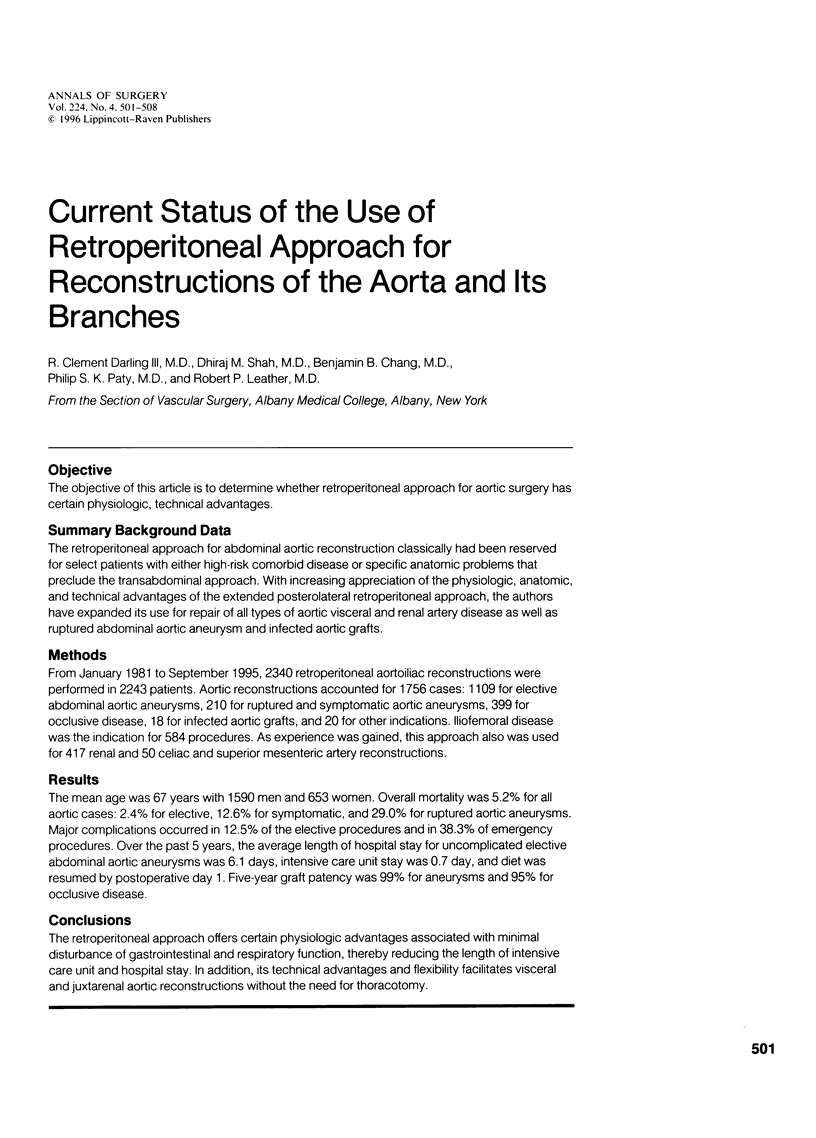
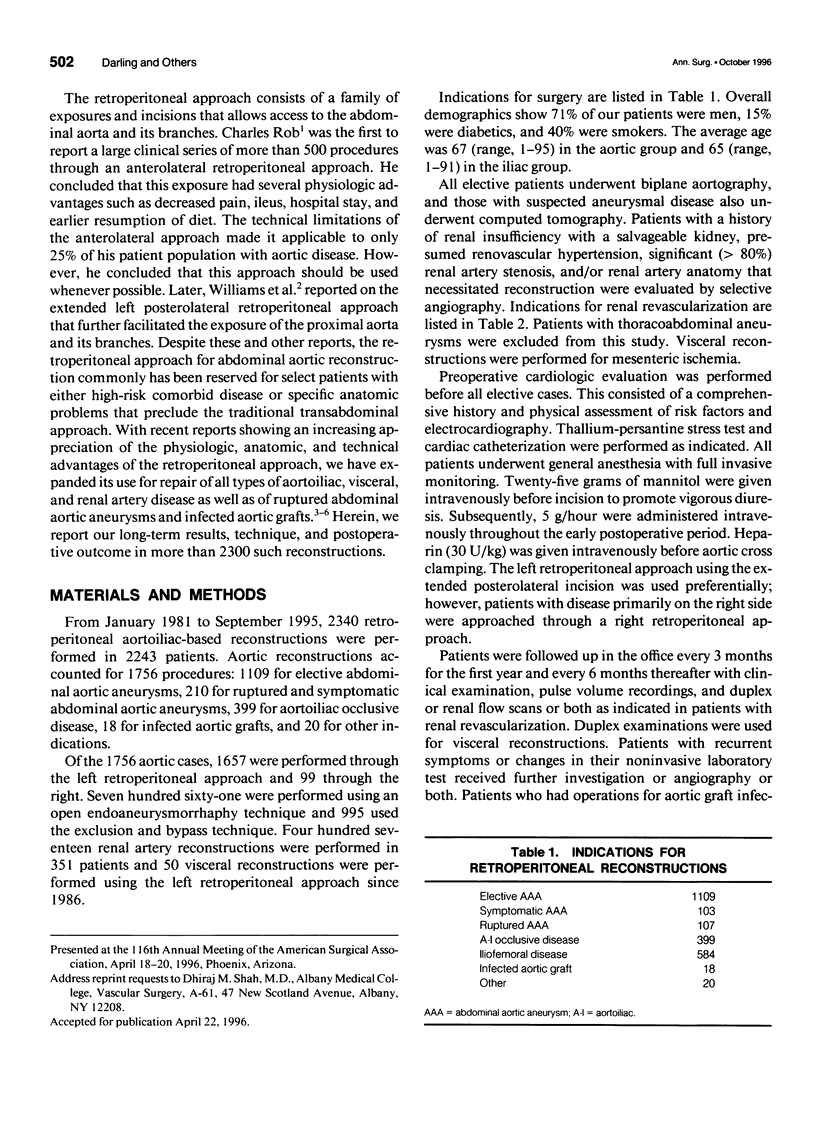

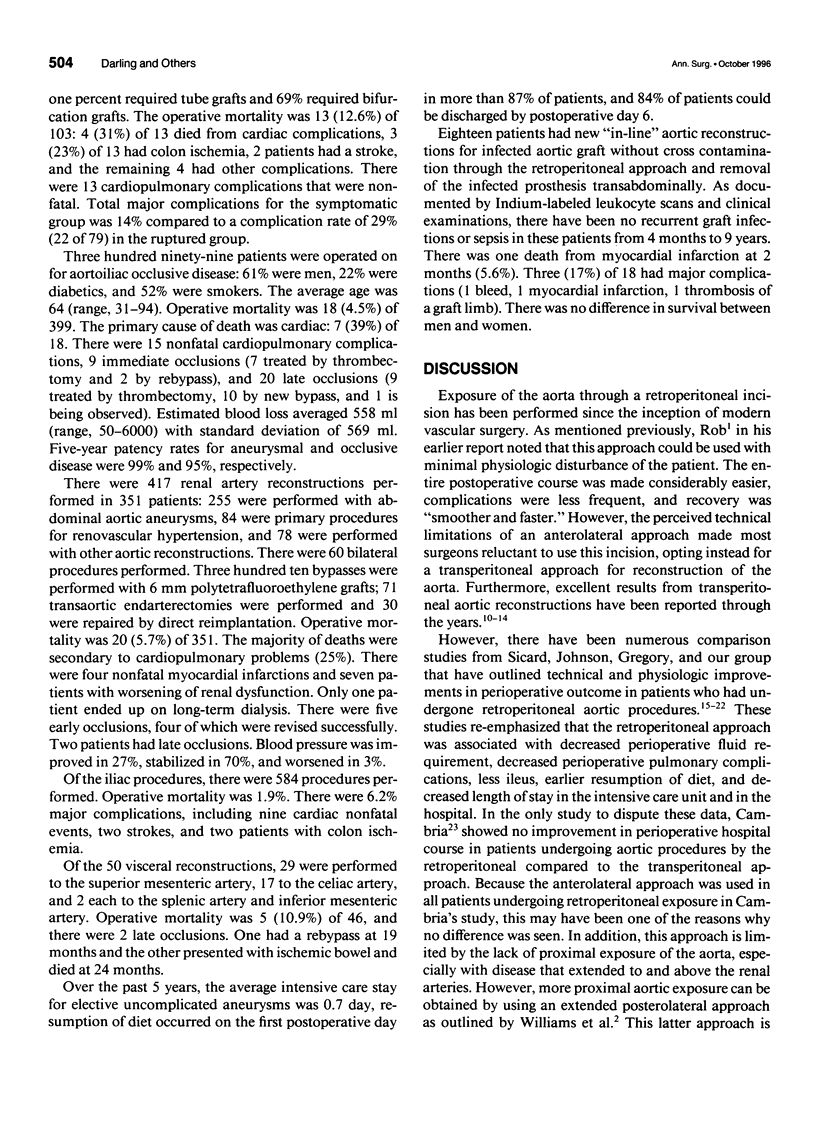
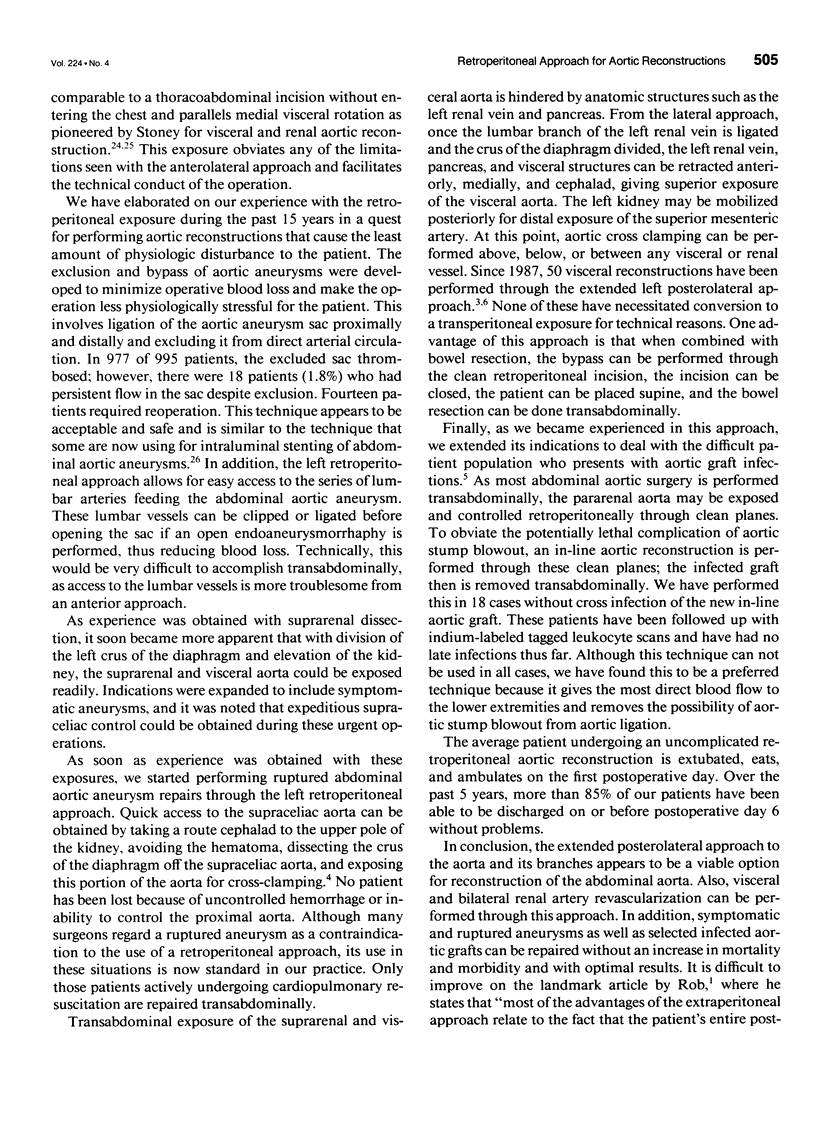
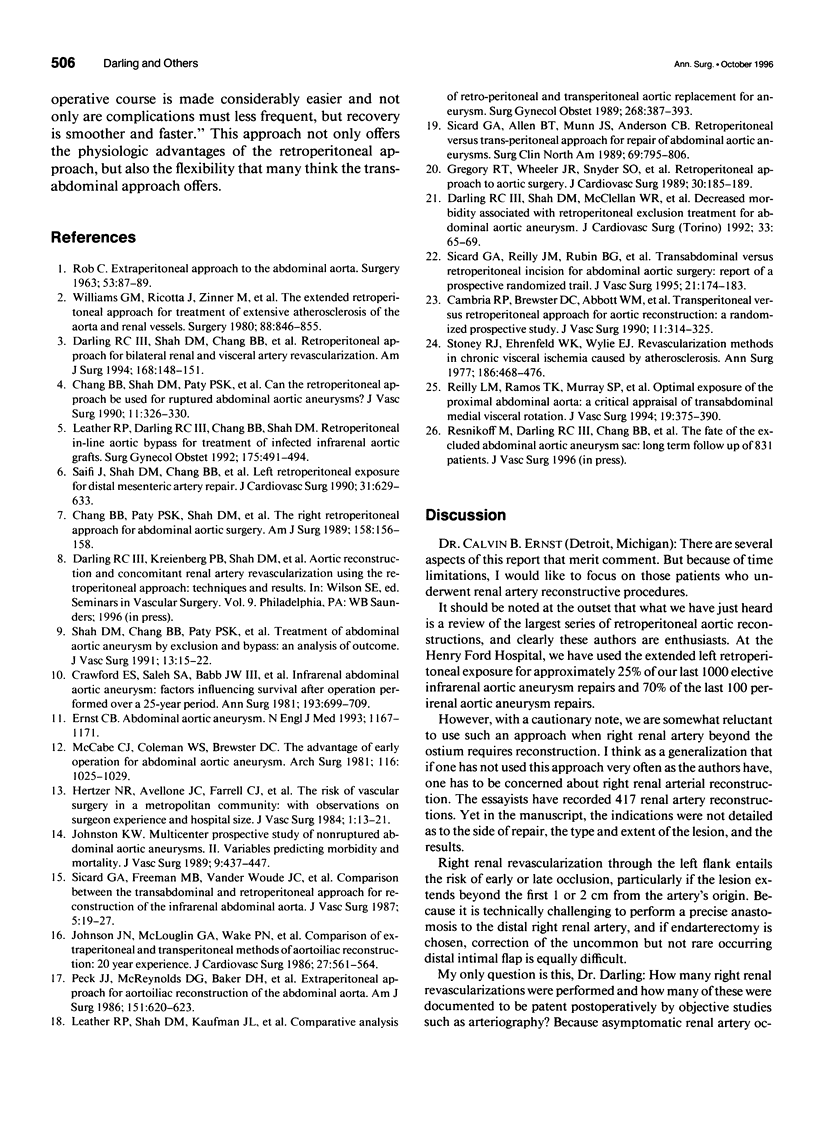
Selected References
These references are in PubMed. This may not be the complete list of references from this article.
- Cambria R. P., Brewster D. C., Abbott W. M., Freehan M., Megerman J., LaMuraglia G., Wilson R., Wilson D., Teplick R., Davison J. K. Transperitoneal versus retroperitoneal approach for aortic reconstruction: a randomized prospective study. J Vasc Surg. 1990 Feb;11(2):314–325. doi: 10.1067/mva.1990.17353. [DOI] [PubMed] [Google Scholar]
- Chang B. B., Paty P. S., Shah D. M., Leather R. P., Kaufman J. L., McClellan W. R. The right retroperitoneal approach for abdominal aortic surgery. Am J Surg. 1989 Aug;158(2):156–158. doi: 10.1016/0002-9610(89)90366-8. [DOI] [PubMed] [Google Scholar]
- Chang B. B., Shah D. M., Paty P. S., Kaufman J. L., Leather R. P. Can the retroperitoneal approach be used for ruptured abdominal aortic aneurysms? J Vasc Surg. 1990 Feb;11(2):326–330. doi: 10.1067/mva.1990.17036. [DOI] [PubMed] [Google Scholar]
- Crawford E. S., Saleh S. A., Babb J. W., 3rd, Glaeser D. H., Vaccaro P. S., Silvers A. Infrarenal abdominal aortic aneurysm: factors influencing survival after operation performed over a 25-year period. Ann Surg. 1981 Jun;193(6):699–709. doi: 10.1097/00000658-198106000-00005. [DOI] [PMC free article] [PubMed] [Google Scholar]
- Darling R. C., 3rd, Shah D. M., Chang B. B., Bock D. E., Leather R. P. Retroperitoneal approach for bilateral renal and visceral artery revascularization. Am J Surg. 1994 Aug;168(2):148–151. doi: 10.1016/s0002-9610(94)80056-1. [DOI] [PubMed] [Google Scholar]
- Darling R. C., 3rd, Shah D. M., McClellan W. R., Chang B. B., Leather R. P. Decreased morbidity associated with retroperitoneal exclusion treatment for abdominal aortic aneurysm. J Cardiovasc Surg (Torino) 1992 Jan-Feb;33(1):65–69. [PubMed] [Google Scholar]
- Ernst C. B. Abdominal aortic aneurysm. N Engl J Med. 1993 Apr 22;328(16):1167–1172. doi: 10.1056/NEJM199304223281607. [DOI] [PubMed] [Google Scholar]
- Gregory R. T., Wheeler J. R., Snyder S. O., Gayle R. G., Love L. P. Retroperitoneal approach to aortic surgery. J Cardiovasc Surg (Torino) 1989 Mar-Apr;30(2):185–189. [PubMed] [Google Scholar]
- Hertzer N. R., Avellone J. C., Farrell C. J., Plecha F. R., Rhodes R. S., Sharp W. V., Wright G. F. The risk of vascular surgery in a metropolitan community. With observations on surgeon experience and hospital size. J Vasc Surg. 1984 Jan;1(1):13–21. [PubMed] [Google Scholar]
- Johnson J. N., McLoughlin G. A., Wake P. N., Helsby C. R. Comparison of extraperitoneal and transperitoneal methods of aorto-iliac reconstruction. Twenty years experience. J Cardiovasc Surg (Torino) 1986 Sep-Oct;27(5):561–564. [PubMed] [Google Scholar]
- Johnston K. W. Multicenter prospective study of nonruptured abdominal aortic aneurysm. Part II. Variables predicting morbidity and mortality. J Vasc Surg. 1989 Mar;9(3):437–447. doi: 10.1067/mva.1989.vs0090437. [DOI] [PubMed] [Google Scholar]
- Leather R. P., Darling R. C., 3rd, Chang B. B., Shah D. M. Retroperitoneal in-line aortic bypass for treatment of infected infrarenal aortic grafts. Surg Gynecol Obstet. 1992 Dec;175(6):491–494. [PubMed] [Google Scholar]
- Leather R. P., Shah D. M., Kaufman J. L., Fitzgerald K. M., Chang B. B., Feustel P. J. Comparative analysis of retroperitoneal and transperitoneal aortic replacement for aneurysm. Surg Gynecol Obstet. 1989 May;168(5):387–393. [PubMed] [Google Scholar]
- McCabe C. J., Coleman W. S., Brewster D. C. The advantage of early operation for abdominal aortic aneurysm. Arch Surg. 1981 Aug;116(8):1025–1029. doi: 10.1001/archsurg.1981.01380200033006. [DOI] [PubMed] [Google Scholar]
- Peck J. J., McReynolds D. G., Baker D. H., Eastman A. B. Extraperitoneal approach for aortoiliac reconstruction of the abdominal aorta. Am J Surg. 1986 May;151(5):620–623. doi: 10.1016/0002-9610(86)90571-4. [DOI] [PubMed] [Google Scholar]
- ROB C. Extraperitoneal approach to the abdominal aorta. Surgery. 1963 Jan;53:87–89. [PubMed] [Google Scholar]
- Reilly L. M., Ramos T. K., Murray S. P., Cheng S. W., Stoney R. J. Optimal exposure of the proximal abdominal aorta: a critical appraisal of transabdominal medial visceral rotation. J Vasc Surg. 1994 Mar;19(3):375–390. doi: 10.1016/s0741-5214(94)70065-6. [DOI] [PubMed] [Google Scholar]
- Saifi J., Shah D. M., Chang B. B., Kaufman J. L., Leather R. P. Left retroperitoneal exposure for distal mesenteric artery repair. J Cardiovasc Surg (Torino) 1990 Sep-Oct;31(5):629–633. [PubMed] [Google Scholar]
- Shah D. M., Chang B. B., Paty P. S., Kaufman J. L., Koslow A. R., Leather R. P. Treatment of abdominal aortic aneurysm by exclusion and bypass: an analysis of outcome. J Vasc Surg. 1991 Jan;13(1):15–22. doi: 10.1067/mva.1991.25236. [DOI] [PubMed] [Google Scholar]
- Sicard G. A., Allen B. T., Munn J. S., Anderson C. B. Retroperitoneal versus transperitoneal approach for repair of abdominal aortic aneurysms. Surg Clin North Am. 1989 Aug;69(4):795–806. doi: 10.1016/s0039-6109(16)44885-1. [DOI] [PubMed] [Google Scholar]
- Sicard G. A., Freeman M. B., VanderWoude J. C., Anderson C. B. Comparison between the transabdominal and retroperitoneal approach for reconstruction of the infrarenal abdominal aorta. J Vasc Surg. 1987 Jan;5(1):19–27. doi: 10.1067/mva.1987.avs0050019. [DOI] [PubMed] [Google Scholar]
- Sicard G. A., Reilly J. M., Rubin B. G., Thompson R. W., Allen B. T., Flye M. W., Schechtman K. B., Young-Beyer P., Weiss C., Anderson C. B. Transabdominal versus retroperitoneal incision for abdominal aortic surgery: report of a prospective randomized trial. J Vasc Surg. 1995 Feb;21(2):174–183. doi: 10.1016/s0741-5214(95)70260-1. [DOI] [PubMed] [Google Scholar]
- Stoney R. J., Ehrenfeld W. K., Wylie E. J. Revascularization methods in chronic visceral ischemia caused by atherosclerosis. Ann Surg. 1977 Oct;186(4):468–476. doi: 10.1097/00000658-197710000-00008. [DOI] [PMC free article] [PubMed] [Google Scholar]
- Williams G. M., Ricotta J., Zinner M., Burdick J. The extended retroperitoneal approach for treatment of extensive atherosclerosis of the aorta and renal vessels. Surgery. 1980 Dec;88(6):846–855. [PubMed] [Google Scholar]


